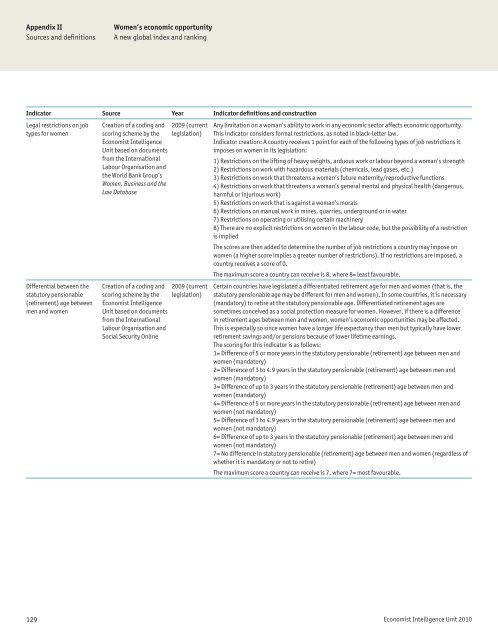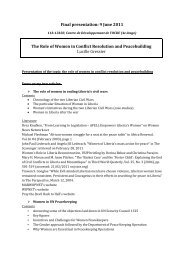Appendix IISources and definitionsWomen’s economic opportunityA new global index and rankingIndicator Source Year Indicator definitions and constructionLegal restrictions on jobtypes for womenDifferential between thestatutory pensionable(retirement) age betweenmen and womenCreation of a coding andscoring scheme by the<strong>Economist</strong> <strong>Intelligence</strong><strong>Unit</strong> based on documentsfrom the InternationalLabour Organisation andthe World Bank Group’sWomen, Business and theLaw DatabaseCreation of a coding andscoring scheme by the<strong>Economist</strong> <strong>Intelligence</strong><strong>Unit</strong> based on documentsfrom the InternationalLabour Organisation andSocial Security Online2009 (currentlegislation)2009 (currentlegislation)Any limitation on a woman’s ability to work in any economic sector affects economic opportunity.This indicator considers formal restrictions, as noted in black-letter law.Indicator creation: A country receives 1 point for each of the following types of job restrictions itimposes on women in its legislation:1) Restrictions on the lifting of heavy weights, arduous work or labour beyond a woman’s strength2) Restrictions on work with hazardous materials (chemicals, lead gases, etc.)3) Restrictions on work that threatens a woman’s future maternity/reproductive functions4) Restrictions on work that threatens a woman’s general mental and physical health (dangerous,harmful or injurious work)5) Restrictions on work that is against a woman’s morals6) Restrictions on manual work in mines, quarries, underground or in water7) Restrictions on operating or utilising certain machinery8) There are no explicit restrictions on women in the labour code, but the possibility of a restrictionis impliedThe scores are then added to determine the number of job restrictions a country may impose onwomen (a higher score implies a greater number of restrictions). If no restrictions are imposed, acountry receives a score of 0.The maximum score a country can receive is 8, where 8= least favourable.Certain countries have legislated a differentiated retirement age for men and women (that is, thestatutory pensionable age may be different for men and women). In some countries, it is necessary(mandatory) to retire at the statutory pensionable age. Differentiated retirement ages aresometimes conceived as a social protection measure for women. However, if there is a differencein retirement ages between men and women, women’s economic opportunities may be affected.This is especially so since women have a longer life expectancy than men but typically have lowerretirement savings and/or pensions because of lower lifetime earnings.The scoring for this indicator is as follows:1= Difference of 5 or more years in the statutory pensionable (retirement) age between men andwomen (mandatory)2= Difference of 3 to 4.9 years in the statutory pensionable (retirement) age between men andwomen (mandatory)3= Difference of up to 3 years in the statutory pensionable (retirement) age between men andwomen (mandatory)4= Difference of 5 or more years in the statutory pensionable (retirement) age between men andwomen (not mandatory)5= Difference of 3 to 4.9 years in the statutory pensionable (retirement) age between men andwomen (not mandatory)6= Difference of up to 3 years in the statutory pensionable (retirement) age between men andwomen (not mandatory)7= No difference in statutory pensionable (retirement) age between men and women (regardless ofwhether it is mandatory or not to retire)The maximum score a country can receive is 7, where 7= most favourable.129 <strong>Economist</strong> <strong>Intelligence</strong> <strong>Unit</strong> 2010
Appendix IISources and definitionsWomen’s economic opportunityA new global index and ranking1b) Labour PracticeIndicator Source Year Indicator definitions and constructionEqual pay for equal work:ILO Equal RemunerationConvention (No 100);country progress inenforcing the provisions ofthe ConventionNon-discrimination:ILO Discrimination(Employment andOccupation) Convention(No 111); country progressin enforcing the provisionsof the ConventionCreation of a codingand scoring schemeby the <strong>Economist</strong><strong>Intelligence</strong> <strong>Unit</strong> basedon International LabourOrganisation documentsCreation of a codingand scoring schemeby the <strong>Economist</strong><strong>Intelligence</strong> <strong>Unit</strong> basedon International LabourOrganisation documents2003-09 Equal pay, codified in law, is a principal step in providing a level playing field for women. Thisindicator is a composite score that considers whether a country is enforcing the Convention’sstipulations, as noted by the ILO. This indicator therefore assesses a country’s compliancewith all terms of the Convention. The <strong>Economist</strong> <strong>Intelligence</strong> <strong>Unit</strong> has created a coding schemebased on the ILO’s annual assessments (noted in the Comments of the Committee of Experts onthe Application of Conventions and Recommendations) of a country’s progress in meeting theConvention’s terms.Indicator creation: A country receives 2 points if the ILO “Notes with satisfaction” each step (seebelow) the country has taken to enforce the terms of the Convention; a country receives 1 pointif the ILO “Notes, Notes with interest, Welcomes, or Looks forward to” each step the country hastaken to enforce the terms of the Convention; or a country receives no points if the ILO “Notes withconcern, Regrets, Urges, Asks, Reminds, Reiterates, Repeats the request, Requests, Drew attentionto” each of the following issues:1) Government policy and organisation/committee to promote Convention principles2) Principle of equality in remuneration in practice3) Principle of equal values in practice4) Job appraisal/evaluation mechanisms5) Co-operation with workers and employers’ organisations to involve them in achieving wageequality6) Law inspection/enforcement mechanismsThe scores are then added to determine the number of steps governments have taken to ensure theenforcement of the principle of equality of pay (a higher score implies better progress in enforcingthe terms of the Convention). Countries that have not ratified the Convention have been assessedby the <strong>Economist</strong> <strong>Intelligence</strong> <strong>Unit</strong> on the same criteria listed above.The maximum score a country can receive is 12, where 12= most favourable.2003-09 Equal opportunity for employment, codified in law, is a principal step in providing a level playingfield for women. This indicator is a composite score which considers if a country is enforcingthe Convention’s stipulations, as noted by the ILO. This indicator therefore assesses a country’scompliance with all the terms of the Convention. The <strong>Economist</strong> <strong>Intelligence</strong> <strong>Unit</strong> has created acoding scheme based on the ILO’s annual assessments (noted in the Comments of the Committeeof Experts on the Application of Conventions and Recommendations) of a country’s progress inmeeting the Convention’s terms.Indicator creation: A country receives 2 points if the ILO “Notes with satisfaction” each step thecountry has taken to enforce the terms of the Convention; a country receives 1 point if the ILO“Notes, Notes with interest, Welcomes, or Looks forward to” each step the country has taken toenforce the terms of the Convention; or a country receives no points if the ILO “Notes with concern,Regrets, Urges, Asks, Reminds, Reiterates, Repeats the request, Requests, Drew attention to” eachof the following issues:1) Establishment of government policy and organisations/committees aimed at achieving equalityand promoting Convention principles2) Principle of the Convention domesticated in labour or other laws3) Legal provisions on sexual harassment4) Co-operation with workers and employers’ organisations to promote and accept principles of theConvention using all means including education and training5) Inspection/enforcement mechanismsThe scores are then added to determine the number of steps governments have taken to ensure theenforcement of the principle of equality of pay (a higher score implies better progress in enforcingthe terms of the Convention). Countries that have not ratified the Convention have been assessedby the <strong>Economist</strong> <strong>Intelligence</strong> <strong>Unit</strong> on the same criteria listed above.The maximum score a country can receive is 10, where 10= most favourable.130 <strong>Economist</strong> <strong>Intelligence</strong> <strong>Unit</strong> 2010




